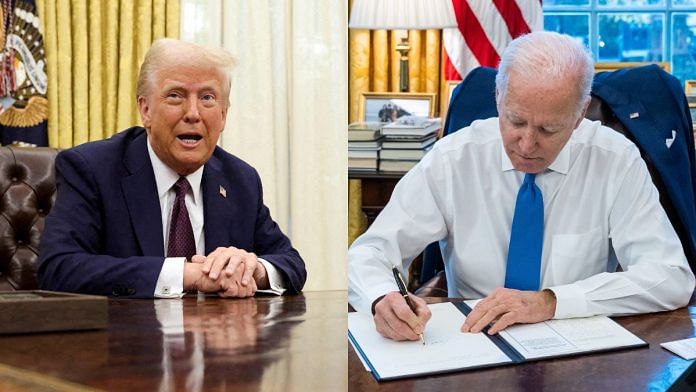New Delhi: US President Donald Trump has claimed that his predecessor Joe Biden’s presidential pardons are “void”, alleging that they were signed with an autopen.
In a post on Truth Social Monday, Trump wrote: “The ‘Pardons’ that Sleepy Joe Biden gave to the Unselect Committee of Political Thugs, and many others, are hereby declared VOID, VACANT, AND OF NO FURTHER FORCE OR EFFECT, because of the fact that they were done by Autopen. In other words, Joe Biden did not sign them but, more importantly, he did not know anything about them!”
He added, “…those on the Unselect Committee, who destroyed and deleted ALL evidence obtained during their two year Witch Hunt of me, and many other innocent people, should fully understand that they are subject to investigation at the highest level.”
Trump was referring to Biden’s preemptive pardons of the members of the committee that investigated the 6 January, 2021 US Capitol attack, and others.
He did not provide any evidence for his allegation that Biden used autopen to sign the pardons. However, the device has been used by many US presidents in the past.
Also Read: ‘$21 mn for voter turnout’ row: MEA has sought details on USAID funds spent in India from US embassy
What is autopen?
An autopen is a machine that automatically replicates a person’s authentic handwritten signature, commonly used by politicians, executives and public figures to sign multiple documents without having to do so physically.
It was patented in the US in 1803. Autopens originally used a carved plastic template to guide a pen to replicate a signature. Today, the process is digital. A mechanical arm holds a pen and replicates a pre-programmed signature.
According to the website of The Autopen Company, which makes the device, it is “the oldest, most commonly used signing machine”, and it has been used by “universities, government agencies, and other institutions for more than 60 years”.
Trump’s claims come after a report from the Heritage Foundation, a conservative think tank, which had alleged that Biden used autopen to sign documents, and argued that his use of the device meant that “whoever controlled the autopen controlled the presidency”.
However, according to a report by fact-check website Snopes, the US National Archives, which runs the Federal Register, has said that official documents published in Federal Register use a copy of the president’s signature that “comes from one graphic file”.
A National Archives spokesperson said that the White House sends a sample of the president’s signature to the Office of the Federal Register, which uses it to create the graphic image for all presidential documents published in the Register.
As the Federal Register’s digitised documents do not represent what the signature looks like on the original documents, the Heritage Foundation’s claim lacks credibility, the Snopes report says.
Past presidents that used autopen
In 2005, George W. Bush became the first US president to ask the Department of Justice if signing a bill with an autopen was constitutional. According to the DoJ, a 2005 memo stated that the president doesn’t need to physically sign a bill for it to become law.
Although Bush reportedly avoided using autopen himself over legal concerns, President Barack Obama became the first president to use it in May 2011. Obama faced criticism for using the device to sign a PATRIOT Act extension while in France. That November, he used the autopen again to sign an appropriations bill while in Indonesia. In 2013, while vacationing in Hawaii, he used it to approve a bill to meet the deadline for signing the fiscal cliff bill.
The Smithsonian Magazine noted that presidents have used signature devices for efficiency since Thomas Jefferson’s time, the third president from 1801 to 1809, who used a polygraph machine that would copy out entire letters, while the individual wrote.
Some presidents openly acknowledged their use of autopen, while others were discreet.
Harry Truman, the 33rd US president, was rumoured to have used an autopen, while 38th US president Gerald Ford openly embraced it. Lyndon B. Johnson brought the autopen into the spotlight by allowing it to be photographed in the White House. It even appeared on the cover of The National Enquirer in 1968 with the headline, “The Robot That Sits in for the President”.
John F. Kennedy relied so heavily on the autopen that it inspired the 1965 book The Robot That Helped to Make a President. Charles Hamilton, the author, had claimed that Kennedy’s real signature was the rarest of all presidential autographs. Though later disproven, his use of autopen marked a shift toward technology in the White House, influencing his successors to make it more public.
Other presidents like Jimmy Carter and Richard Nixon have also reportedly used autopen.
Trump has also accused the select committee members of orchestrating their own pardons and suggested that they should be investigated.
The US Constitution says that a president has the power to grant reprieves and pardons for offences against the United States, except in cases of impeachment. Pardons represent legal forgiveness, and are among the most absolute and unchallengeable powers of the president. However, the US Constitution does not make any mention of subsequent presidents having authority to revoke the pardons.
Varnika Dhawan is an intern with ThePrint.
(Edited by Mannat Chugh)
Also Read: Modi invokes ‘India First’ in response to question about Trump, praises ‘resilient’ US President






